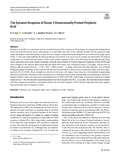- CERES Home
- →
- Cranfield Defence and Security
- →
- Staff publications (CDS)
- →
- View Item
JavaScript is disabled for your browser. Some features of this site may not work without it.
| dc.contributor.author | Agu, Henry | |
| dc.contributor.author | Hameed, Amer | |
| dc.contributor.author | Appleby-Thomas, Gareth J. | |
| dc.contributor.author | Wood, David | |
| dc.date.accessioned | 2019-06-04T15:37:28Z | |
| dc.date.available | 2019-06-04T15:37:28Z | |
| dc.date.issued | 2019-05-22 | |
| dc.identifier.citation | Agu HO, Hameed A, Appleby-Thomas GJ, Wood DC. (2019) The dynamic response of dense 3 dimensionally printed polylactic acid. Journal of Dynamic Behavior of Materials, Volume 5, December 2019, pp. 377-386 | en_UK |
| dc.identifier.issn | 2199-7446 | |
| dc.identifier.uri | https://doi.org/10.1007/s40870-019-00198-8 | |
| dc.identifier.uri | http://dspace.lib.cranfield.ac.uk/handle/1826/14224 | |
| dc.description.abstract | Polylactic acid (PLA) is commonly used as a feedstock material for commercial 3D printing. As components manufactured from such material become more commonplace, it is inevitable that some of the resultant systems will be exposed to high strain-rate/impact events during their design-life (for example, components being dropped or even involved in a high-speed crash). To this end, understanding the shock properties of polylactic acid, in its role as a major raw material for 3D printed components, is of particular importance. In this work, printed samples of PLA were deformed by one-dimensional shock waves generated via the plate impact technique, allowing determination of both the Hugoniot Equation of State (EOS) and shear strength of the material. Both linear and non-linear EOS forms were considered in the US-Up plane, with the best-fit found to take the general form US=1.28+3.06−1.09Up2" role="presentation" style="display: inline-table; line-height: normal; letter-spacing: normal; word-spacing: normal; overflow-wrap: normal; white-space: nowrap; float: none; direction: ltr; max-width: none; max-height: none; min-width: 0px; min-height: 0px; border-width: 0px; border-style: initial; position: relative;">US=1.28+3.06−1.09U2pUS=1.28+3.06−1.09Up2 in the Us−Up" role="presentation" style="display: inline-table; line-height: normal; letter-spacing: normal; word-spacing: normal; overflow-wrap: normal; white-space: nowrap; float: none; direction: ltr; max-width: none; max-height: none; min-width: 0px; min-height: 0px; border-width: 0px; border-style: initial; position: relative;">Us−UpUs−Up plane, consistent with other polymers. Use of lateral Manganin gauges embedded in the material flow allowed consideration of lateral stress evolution at impact pressures ranging from 0.3 to 4.0 GPa. Shear strength was observed to increase with impact stress, however, with minimal strengthening behind the shock front. Deviation of the measured stress from the predicted elastic measurement (corresponding to the PLA’s Hugoniot Elastic Limit) was observed at longitudinal stress of 0.90 ± 0.05 GPa, within range of polymeric materials of similar characteristics—the first time this important parameter has been measured for PLA. As a result, this material characterisation will allow numerical modellers to accurately predict the structural response of PLA-based components/structures against high strain rates such as impacts or drops. | en_UK |
| dc.language.iso | en | en_UK |
| dc.publisher | Springer | en_UK |
| dc.rights | Attribution 4.0 International | * |
| dc.rights.uri | http://creativecommons.org/licenses/by/4.0/ | * |
| dc.subject | Polylactic acid | en_UK |
| dc.subject | Hugoniot elastic limit | en_UK |
| dc.subject | Equations of state | en_UK |
| dc.subject | Polymer | en_UK |
| dc.title | The dynamic response of dense 3 dimensionally printed polylactic acid | en_UK |
| dc.type | Article | en_UK |
Files in this item
The following license files are associated with this item:
This item appears in the following Collection(s)
-
Staff publications (CDS) [1209]

